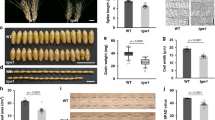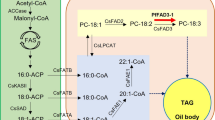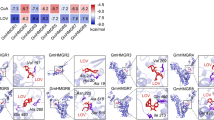Abstract
Tocotrienols are the primary form of vitamin E in seeds of most monocot plants, including cereals such as rice and wheat. As potent antioxidants, tocotrienols contribute to the nutritive value of cereal grains in human and livestock diets. cDNAs encoding homogentisic acid geranylgeranyl transferase (HGGT), which catalyzes the committed step of tocotrienol biosynthesis, were isolated from barley, wheat and rice seeds. Transgenic expression of the barley HGGT in Arabidopsis thaliana leaves resulted in accumulation of tocotrienols, which were absent from leaves of nontransformed plants, and a 10- to 15-fold increase in total vitamin E antioxidants (tocotrienols plus tocopherols). Overexpression of the barley HGGT in corn seeds resulted in an increase in tocotrienol and tocopherol content of as much as six-fold. These results provide insight into the genetic basis for tocotrienol biosynthesis in plants and demonstrate the ability to enhance the antioxidant content of crops by introduction of an enzyme that redirects metabolic flux.
This is a preview of subscription content, access via your institution
Access options
Subscribe to this journal
Receive 12 print issues and online access
$209.00 per year
only $17.42 per issue
Buy this article
- Purchase on Springer Link
- Instant access to full article PDF
Prices may be subject to local taxes which are calculated during checkout






Similar content being viewed by others

References
Padley, F.B., Gunstone, F.D. & Harwood, J.L. in The Lipid Handbook, 2nd Edn. (eds. Gunstone, F.D., Harwood, J.L., and Padley, F.B.) 130 (Chapman & Hall, London, 1994).
Aitzetmüller, K. Antioxidative effects of Carum seeds. J. Am. Oil Chem. Soc. 74, 185 (1997).
Kamal-Eldin, A. & Appelqvist, L.A. The chemistry and antioxidant properties of tocopherols and tocotrienols. Lipids 31, 671–701 (1996).
Barnes, P.J. Cereal tocopherols. Dev. Food Sci. 5B, 1095–1100 (1983).
Peterson, D.M. & Qureshi, A.A. Genotype and environmental effects on tocols of barley and oats. Cereal Chem. 70, 157–162 (1993).
Serbinova, E.A. & Packer, L. Antioxidant properties of α-tocopherol and α-tocotrienol. Methods Enzymol. 234, 354–366 (1994).
Packer, L., Weber, S.U. & Rimbach, G. Molecular aspects of α-tocotrienol antioxidant action and cell signalling. J. Nutr. 131, 369S–373S (2001).
Andlauer, W. & Fürst, P. Antioxidative power of phytochemicals with special reference to cereals. Cereal Foods World 43, 356–359 (1998).
Wang, L., Newman, R.K., Newman, C.W., Jackson, L.L. & Hofer, P.J. Tocotrienol and fatty acid composition of barley oil and their effects on lipid metabolism. Plant Foods Hum. Nutr. 43, 9–17 (1993).
Suzuki, Y.J. et al. Structural and dynamic membrane properties of α-tocopherol and α-tocotrienol: implication to the molecular mechanism of their antioxidant potency. Biochemistry 32, 10692–10699 (1993).
Theriault, A., Chao, J.-T., Wang, Q., Gapor, A. & Adeli, K. Tocotrienol: a review of its therapeutic potential. Clin. Biochem. 32, 309–319 (1999).
Qureshi, A.A., Burger, W.C., Peterson, D.M. & Elson, C.E. The structure of an inhibitor of cholesterol biosynthesis isolated from barley. J. Biol. Chem. 261, 10544–10550 (1986).
Parker, R.A., Pearce, B.C., Clark, R.W., Gordon, D.A. & Wright, J.J. Tocotrienols regulate cholesterol production in mammalian cells by post-transcriptional suppression of 3-hydroxy-3-methylglutaryl-coenzyme A reductase. J. Biol. Chem. 268, 11230–11238 (1993).
Raederstorff, D., Elste, V., Aebischer, C. & Weber, P. Effect of either γ-tocotrienol or a tocotrienol mixture on the plasma lipid profile in hamsters. Ann. Nutr. Metab. 46, 17–23 (2002).
Elson, C.E. & Yu, S.G. The chemoprevention of cancer by mevalonate-derived con-stituents of fruits and vegetables. J. Nutr. 124, 607–614 (1994).
Nesaretnam, K., Stephen, R., Dils, R. & Darbre, P. Tocotrienols inhibit the growth of human breast cancer cells irrespective of estrogen receptor status. Lipids 33, 461–469 (1998).
Schultz, G., Soll, J., Fiedler, E. & Schulze-Siebert, D. Synthesis of prenylquinones in chloroplasts. Physiol. Plant. 64, 123–129 (1985).
Soll, J., Kemmerling, M. & Schultz, G. Tocopherol and plastoquinone synthesis in spinach chloroplasts subfractions. Arch. Biochem. Biophys. 204, 544–550 (1980).
Collakova, E. & DellaPenna, D. Isolation and functional analysis of homogentisate phytyltransferase from Synechocystis sp. PCC 6803 and Arabidopsis. Plant Physiol. 127, 1113–1124 (2001).
Savidge, B. et al. Isolation and characterization of homogentisate phytyltransferase genes from Synechocystis sp. PCC 6803 and Arabidopsis. Plant Physiol. 129, 321–332 (2002).
Schledz, M., Seidler, A., Beyer, P. & Neuhaus, G. A novel phytyltransferase from Synechocystis sp. PCC 6803 involved in tocopherol biosynthesis. FEBS Lett. 499, 15–20 (2001).
Soll, J. & Schultz, G. Comparison of geranylgeranyl and phytyl substituted methylquinols in the tocopherol synthesis of spinach chloroplasts. Biochem. Biophys. Res. Commun. 91, 715–720 (1979).
Collakova, E. & DellaPenna, D. Homogentisate phytyltransferase activity is limiting for tocopherol biosynthesis in Arabidopsis. Plant Physiol. 131, 632–642 (2003).
Grams, G.W., Blessin, C.W. & Inglett, G.E. Distribution of tocopherols within the corn kernel. J. Am. Oil Chem. Soc. 47, 337–339 (1970).
Goffman, F.D. & Böhme, T. Relationship between fatty acid profile and vitamin E content of maize hybrids (Zea mays L.) J. Agric. Food Chem. 49, 4990–4994 (2001).
Lee, K. & Huang, A.H. Genes encoding oleosins in maize kernel of inbreds Mo17 and B73. Plant Mol. Biol. 26, 1981–1987 (1994).
Porfirova, S., Bergmüller, E., Tropf, S., Lemke, R. & Dörmann, P. Isolation of an Arabidopsis mutant lacking vitamin E and identification of a cyclase essential for all tocopherol biosynthesis. Proc. Natl. Acad. Sci. USA 99, 12495–12500 (2002).
Shintani, D. & DellaPenna, D. Elevating the vitamin E content of plants through metabolic engineering. Science 282, 2098–2100 (1998).
Fryer, M.J. The antioxidant effects of thylakoid vitamin E (α-tocopherol). Plant Cell Environ. 15, 381–392 (1992).
Demmig-Adams, B. & Adams, W.W. Antioxidants in photosynthesis and human nutrition. Science 298, 2149–2153 (2002).
Cahoon, E.B. et al. Biosynthetic origin of conjugated double bonds: production of fatty acid components of high-value drying oils in transgenic somatic soybean embryos. Proc. Natl. Acad. Sci. USA 96, 12935–12940 (1999).
Cahoon, E.B., Ripp, K.G., Hall, S.E. & Kinney, A.J. Formation of conjugated Δ8, Δ10-double bonds by Δ12-oleic acid desaturase-related enzymes. Biosynthetic origin of calendic acid. J. Biol. Chem. 276, 2637–2643 (2001).
Rogers, S.G., Horsch, R.B. & Fraley, R.T. Gene transfer in plants: production of transformed plants using Ti plasmid vectors. Methods Enzymol. 118, 627–640 (1986).
Bechtold, N., Ellis, J. & Pelletier, G. In planta Agrobacterium-mediated gene transfer by infiltration of adult Arabidopsis thaliana plants. C.R. Acad. Sci. Paris 316, 1194–1199 (1993).
Nair, P.P. & Luna, Z. Identification of α-tocopherol from tissues by combined gas-liquid chromatography, mass spectrometry and infrared spectroscopy. Arch. Biochem. Biophys. 127, 413–418 (1968).
Frega, N., Mozzon, M. & Bocci, F. Identification and estimation of tocotrienols in the annatto lipid fraction by gas chromatography–mass spectrometry. J. Am. Oil Chem. Soc. 75, 1723–1728 (1998).
Lichtenthaler, H.K. Chlorophylls and carotenoids: pigments of photosynthetic membranes. Methods Enzymol. 148, 350–382 (1987).
Bligh, E.G. & Dyer, W.J. A rapid method of total lipid extraction and purification. Can. J. Biochem. Physiol. 37, 911–917 (1959).
Glassman, K.F. et al. Recombinant constructs and their use in reducing gene expression. PCT WO 0200904 (2002).
Gordon-Kamm, W. et al. Stimulation of the cell cycle and maize transformation by disruption of the plant retinoblastoma pathway. Proc. Natl. Acad. Sci. USA 99, 11975–11980 (2002).
Saitou, N. & Nei, M. The neighbor-joining method: a new method for reconstructing phylogenetic trees. Mol. Biol. Evol. 4, 406–425 (1987).
Acknowledgements
We thank Jerry Ranch for conducting the corn transformation experiments. We also thank Alfred Ciuffetelli for assistance with corn seed analyses and Trissa Miller and Rebecca Cahoon for critical reading of the manuscript.
Author information
Authors and Affiliations
Corresponding author
Ethics declarations
Competing interests
Patent applications have been filed on the sequences and utility of the cDNAs described in the manuscript.
Supplementary information
Rights and permissions
About this article
Cite this article
Cahoon, E., Hall, S., Ripp, K. et al. Metabolic redesign of vitamin E biosynthesis in plants for tocotrienol production and increased antioxidant content. Nat Biotechnol 21, 1082–1087 (2003). https://doi.org/10.1038/nbt853
Received:
Accepted:
Published:
Issue Date:
DOI: https://doi.org/10.1038/nbt853
This article is cited by
-
Engineered Saccharomyces cerevisiae for de novo δ-tocotrienol biosynthesis
Systems Microbiology and Biomanufacturing (2024)
-
Comparative gene retention analysis in barley, wild emmer, and bread wheat pangenome lines reveals factors affecting gene retention following gene duplication
BMC Biology (2023)
-
Recent trends in the biotechnological production of tocopherols using in vitro cultures
Phytochemistry Reviews (2021)
-
Fumarylacetoacetate hydrolase is required for fertility in rice
Planta (2021)


